Asta Funding, (NASDAQ:ASTA), is in the business of acquiring, servicing, and collecting distressed consumer receivables – primarily credit card receivables.
I wrote a few articles about Asta in Dec 2009 – Jan 2010 on my previous blog here, here, and here.
Since that time, it has traded as low as $6.00 and as high as $10.03, overall trailing the return of the S&P 500 as shown below.
Today I think it presents a compelling investment opportunity.
To be sure, the company has faced headwinds in the past few years.
Its business depends on collecting receivables from individuals with poor credit, often through wage garnishments or property attachments. But with high unemployment hitting these consumers hard and falling housing prices exasperating overextended, low credit consumers, the great recession has dried up these collection channels.
A key challenge to investing in Asta is that cash flows from these pools of distressed receivables are difficult to predict, and therefore hard to value.
GAAP accounting for these pools requires a host of assumptions to determine what is a return ON investment versus a return OF investment. The assumptions are so numerous it makes relying on reported book values and income difficult.
Still, at $6.70 per share, Asta seems cheap by almost any yardstick.
Here’s What You Get Per Share of Asta Funding:
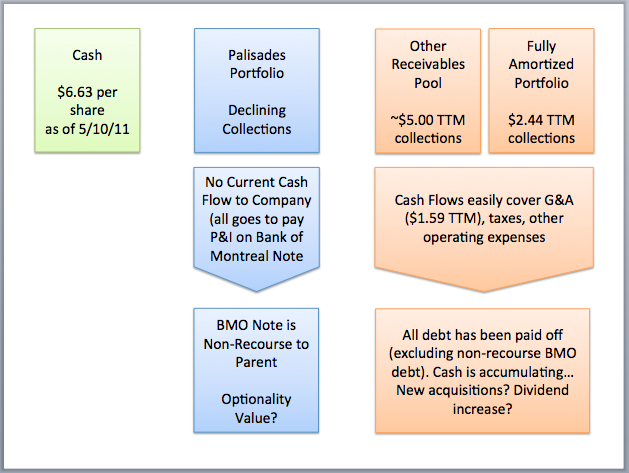 According to a press release, they had a cash balance on May 10, 2011 of approximately $97 Million ($6.63 per share outstanding). The company is cash flow positive and pays a small dividend of $0.08 per share.
According to a press release, they had a cash balance on May 10, 2011 of approximately $97 Million ($6.63 per share outstanding). The company is cash flow positive and pays a small dividend of $0.08 per share.
For sake of this analysis, I will divide Asta’s portfolio of receivables into 3 buckets, as shown in the chart above:
- The Palisades Portfolio Pool
- The Other Receivables Pool
- The Fully Amortized Pool
Bucket 1: The Palisades Portfolio Pool
Historically Asta Funding purchased smaller portfolios of receivables – up to approximately $15 million. Then in March 2007, they paid $300 million to acquire one large portfolio. I will refer to it as the “Palisades Portfolio,” but if you are reading their SEC filings it is also sometimes referred to as the “Great Seneca Portfolio,” “The Portfolio Purchase,” and a few other names. The portfolio has not performed well, falling behind expectations almost immediately.
To purchase the portfolio, Asta formed a wholly-owned subsidiary, “Palisades XVI.” The $300 million was financed with a $227 million loan from Bank of Montreal, and $75 million from the parent company’s line of credit.
The portfolio has performed poorly, Asta has impaired the portfolio a total of $97.2 MM on its books, and the Bank of Montreal debt note has been repeatedly modified.
The current loan modification requires that all cash flows from the portfolio go to pay interest and principal to BMO with minimum monthly principal payments of $750,000.
While none of this is good news, the key is that the Bank of Montreal debt is in a bankruptcy remote subsidiary. Even if cash collections from the portfolio are insufficient, the parent company is not obligated to cover the debt.
There is also some optionality value to the extent future collections ultimately surpass the required debt payments.
Buckets 2 & 3:
Bucket 2 consists of other pools of receivables.
As I noted above, GAAP accounting for these assets requires many assumptions to determine when cash collected is recognized as a return ON investment versus a return OF investment. The accounting for most of this pool follows guidance from the American Institute of Certified Public Accountants (AICPA) Statement of Position 03-3.
The cash flows in this bucket have been declining in large part due to the company not purchasing new portfolios of assets as discussed below under “Aggressive Deleveraging and Cash Conservation.”
Because of all the accounting assumptions, pools from bucket 2 can outlive their projections and continue to cash flow after the principal balance has been fully amortized on the books. At this point, all cash flows are recorded as income.
It is these cash flows that I am referring to as bucket 3. The company does not provide guidance on the cash flows to be expected, but a historical analysis shows a good degree of persistence.
And it makes sense that these pools would exhibit a degree of persistence. The pools are made up of thousands of individual receivables and much of the collections come from wage garnishments.
The graphic below shows total cash collections from the fully amortized pool (bucket 3) and the total cash flows from pools that are on the interest method of accounting (as governed by AICPA SOP 03-3). This 2nd group represents approximately 90% of the total cash flows for bucket 2. (The buckets are my own analytical distinction, the company does not report on these buckets, making it hard to track them exactly. Nevertheless, the ~90% gives a conservative view and doesn’t take away from the analysis).
Aggressive Deleveraging and Cash Conservation
For the past three years, Asta has been on a campaign of aggressive deleveraging and cash conservation.
It has scaled back dramatically on new purchases of distressed receivable pools as shown below:
This has led to an overall decline in assets and the decline in cash flows (described above) as the older pools continue to be repaid by the underlying debtors.
But in the short term it has also freed up cash flow to deleverage.
Below is the total debt outstanding for the last 4 fiscal years (excluding the non-recourse Bank of Montreal debt).
Excluding the Bank of Montreal note, the debt is now all paid off (remaining balance from FY end 2010 has subsequently been repaid), and with the added help of a $52.7 MM tax refund, Asta has accumulated cash as shown below:
Despite their decline, with no interest payments the cash flows from the fully amortized and interest method pools (again ~90% of bucket 2 and all of bucket 3) seem more than sufficient to cover operating expenses, as the graph below suggests:
Ultimately Asta will need to decide what to do with all the cash. But whatever it decides, at $6.70 per share, the cash balance and positive cash flows provides an investor with good downside protection in this company.
Update: Asta Funding was recently deleted from the Russell 3000 index, an index of the largest companies by market cap. This will likely provide selling pressure in the short term as index funds sell indiscriminately to rebalance but, in my opinion, may provide a good buying opportunity for long-term investors.
Author Disclosure: Author has a long position in Asta Funding at the time of writing.
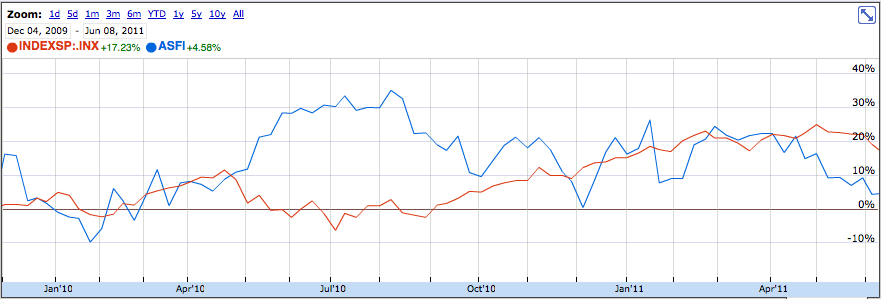
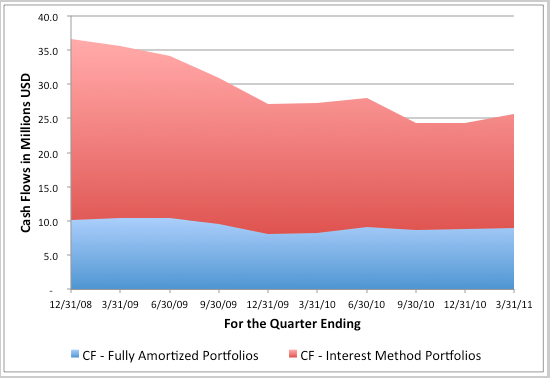
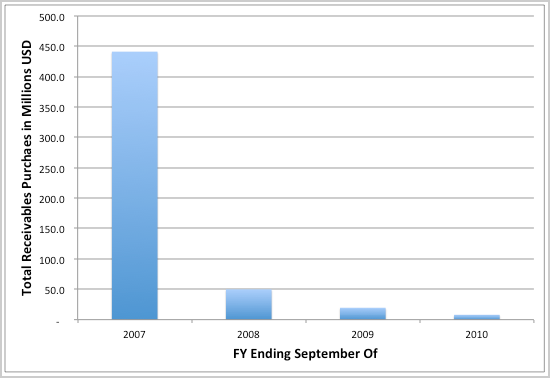
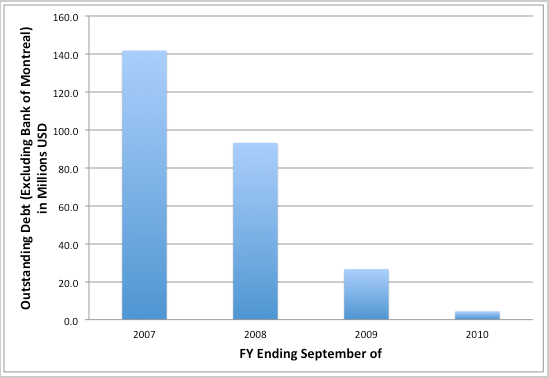
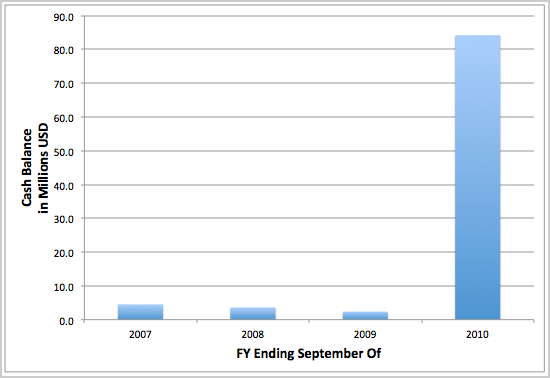
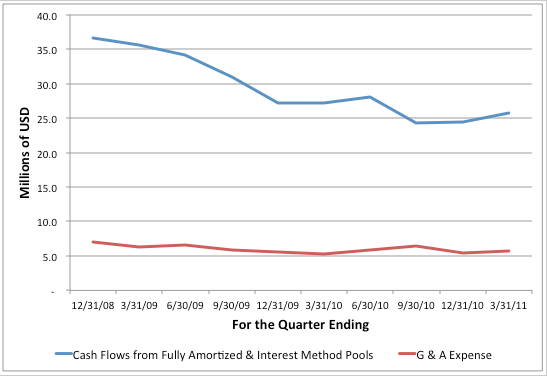
[…] I start, let me point you to an excellent write up over at totally invested. He wrote this about a week before the company announced a big stock buyback that has sent the […]